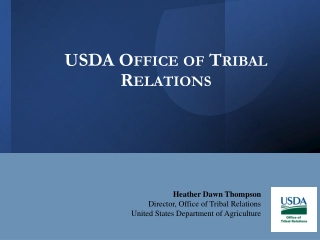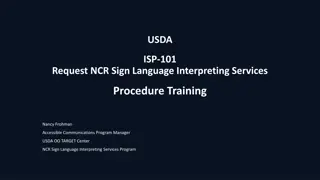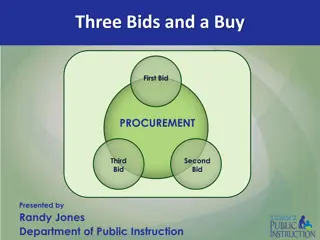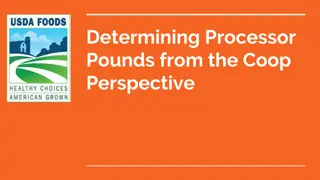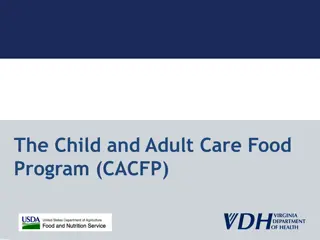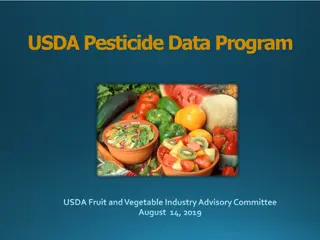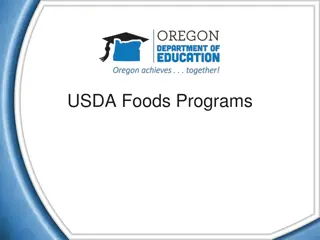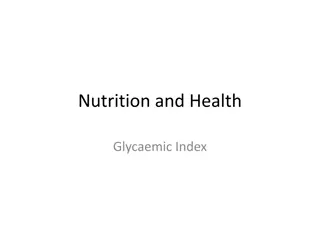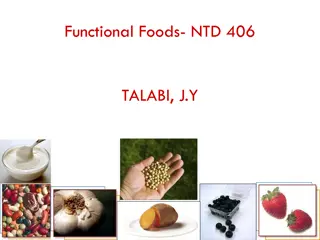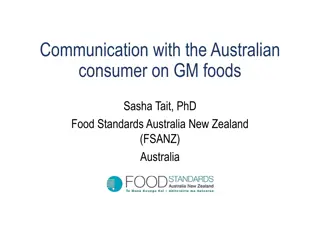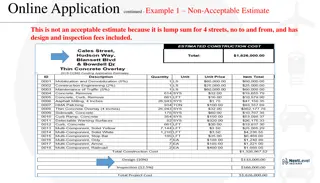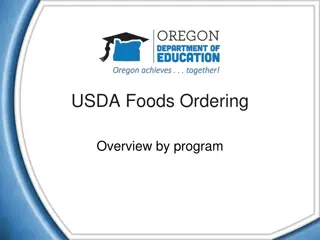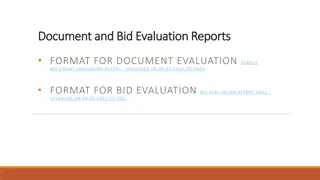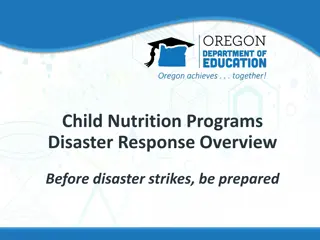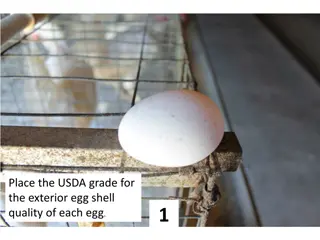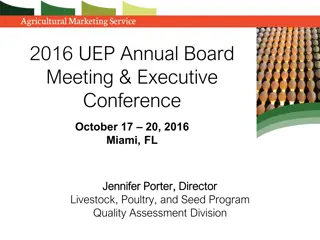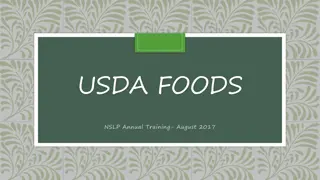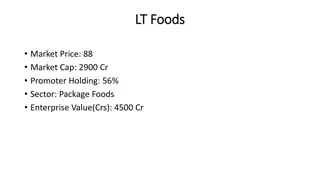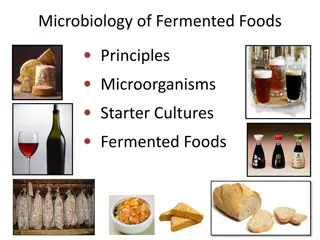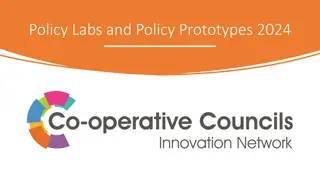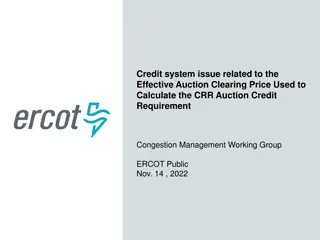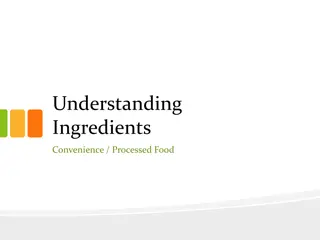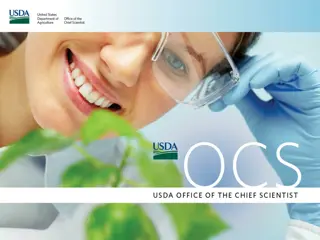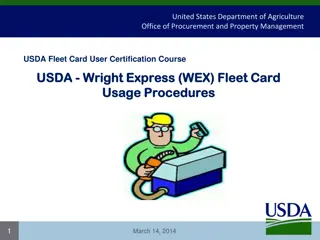USDA Tribal Relations and Federal Policy in Native Agriculture
Explore the role of the USDA Office of Tribal Relations and the USDA Tribal Advisory Committee in addressing barriers and federal policies impacting tribal agriculture. Learn about tribal eligibility, statutory requirements, and the historical eras of federal Indian policy affecting Native American
0 views • 36 slides
Complete Guide to Responding to Bids and Quotes in Vendor Training Session
In this comprehensive training session, learn about the different procurement types such as IFB, RFP, Small Purchase, and more. Understand the process of obtaining and responding to bids, acknowledging receipt, attaching documents, revising quotes, and accessing vendor resources. Discover the benefi
1 views • 14 slides
Streamlined Forecasting for Future USDA Foods Utilization
Cathy Sparks, National Commodity Director, discusses the importance of communication in the forecasting process for USDA foods. Tools like the ProcessorLink calculator and K12 On Target planner help processors and distributors estimate quantities needed for production. Commodity Planning Made Easy s
1 views • 9 slides
USDA Accessible Communications Program Overview
Advancing access and equity for individuals with disabilities is a key focus of the USDA Accessible Communications Program. Through initiatives like the National Disability Employment Awareness Month events and implementing the Rehabilitation Act, the program aims to promote accessible communication
5 views • 28 slides
Effective USDA Foods Procurement and Forecasting Strategies
Managing USDA Foods procurement involves analyzing historical data, estimating future trends, and streamlining menu planning to save time and reduce costs. Standardized recipes and inventory management are crucial for efficient operations. Understanding the location and value of USDA Foods, along wi
8 views • 11 slides
USDA In-Person Sign Language Interpreting Services Training Overview
This training session provides essential information for USDA employees on requesting in-person and virtual sign language interpreting services in the National Capital Region. It covers policy reviews, training completion, requesting procedures, and resources available through the USDA NCR Sign Lang
0 views • 23 slides
Understanding USDA Watershed Programs for Local Communities
USDA Watershed Programs offer assistance in addressing natural resource issues such as flood control, repairing flood damages, and rehabilitating flood control dams. The three major components - Emergency Watershed Program (EWP), Watershed Protection and Flood Control Program (WPFO), and Watershed R
0 views • 15 slides
Understanding BIDS File Naming Conventions
BIDS (Brain Imaging Data Structure) establishes standardized naming conventions for organizing neuroimaging data. It outlines rules for labeling subjects, sessions, tasks, runs, modalities, and exceptions. The structure helps maintain consistency and facilitates data sharing and collaboration in the
7 views • 11 slides
Streamlining Small Purchases with Three Bids and a Buy Approach
Streamline your small purchases efficiently using the Three Bids and a Buy method. Learn the steps involved in planning bids, contacting vendors, selecting the best bid, managing the contract, and maintaining records for effective procurement processes.
0 views • 19 slides
Co-op Perspective on Processor Pounds and Food Forecasting for Schools
Co-ops and purchasing organizations offer benefits to schools by providing pricing advantages and access to high-quality items. Planning for the 2024-2025 school year involves meetings, food shows, and student testing. USDA Foods bids require collecting volume estimates and historical data from memb
0 views • 5 slides
Shadow Opinion on Activation Purposes Proposal: Insights and Recommendations
The shadow opinion addresses definitions, interpretations, and the proposed classification criteria for activation purposes in balancing energy bids. It discusses the clarity of terminology, necessity of terms, and the need for a comprehensive list of possible purposes. Additionally, it raises conce
0 views • 7 slides
Overview of Child and Adult Care Food Program (CACFP)
The Child and Adult Care Food Program (CACFP) is a federally funded program aimed at subsidizing eligible institutions to provide nutritious meals to children and adults, promoting lifelong healthy eating and physical activity habits. Administered by the USDA and implemented by various programs, CAC
0 views • 21 slides
Understanding Healthy Nutrition Choices
Healthy foods include a variety of nutrient-rich options such as fruits, vegetables, whole grains, lean proteins, and low-fat dairy products. Carbohydrate foods can be found in sources like fruits, whole grains, and legumes. Protein-rich foods include meat, fish, poultry, dairy, and plant-based prot
0 views • 14 slides
USDA Pesticide Data Program Overview
The USDA Pesticide Data Program (PDP) provides high-quality pesticide residue data for US foods to support regulatory decision-making and ensure food safety. Through cooperative agreements with participating states, the program conducts sampling of various commodities, including fresh fruits and veg
0 views • 17 slides
Overview of USDA Foods Programs and Delivery Methods
The USDA Foods Programs offer various initiatives like Direct Delivery, Diversion/Processing, DoD Fresh Fruit and Vegetable Program, and Unprocessed Fruit and Vegetable Pilot. These programs provide schools with access to a wide range of food products procured through different methods, including bu
1 views • 10 slides
Overview of USDA Food Distribution Program
The USDA Food Distribution Program aims to support American agricultural markets and provide nutritious food to schools. With over 17 million entitlements distributed annually, the program ensures that USDA foods are domestic and meet nutritional goals. Service fees cover various administrative cost
0 views • 15 slides
Understanding Glycaemic Index in Nutrition and Health
Glycaemic Index (GI) measures how carbohydrate-containing foods affect blood glucose levels. High GI foods raise blood glucose rapidly, while low GI foods release glucose gradually. Studies track impacts on blood glucose levels, insulin secretion, fat storage, and pancreatic function. High GI foods
0 views • 15 slides
Exploring Functional Foods for Health Benefits
Functional foods are dietary components consumed primarily for health reasons, providing benefits beyond basic nutrition. Types of functional foods include beans, berries, cruciferous vegetables, and cocoa products. Beans contain saponins that may help protect against cancers and lower cholesterol l
0 views • 24 slides
Effective Communication Strategies on GM Foods in Australia
Sasha Tait from FSANZ addresses the challenges faced in communicating with Australian consumers on GM foods due to values-based opposition. The country's transparency initiatives include public consultations and responses, increasing awareness. Social media presence allows direct communication. Usin
0 views • 10 slides
Managing USDA Food Receiving and Inventory Basics
Learn about the processes involved in receiving USDA foods, managing inventory using FIFO, understanding storage conditions, determining expiration dates, and interpreting best-if-used-by dates. Ensure proper handling and storage to maintain food quality and safety.
0 views • 15 slides
Best Practices for Contractors: Examples of Acceptable and Non-Acceptable Estimates and Bids
Explore examples of acceptable and non-acceptable estimates and bids for contractors in online applications. Learn why lump sum estimates, lack of detailed information, and incorrect unit bidding can impact the bidding process negatively. Discover how clarity, itemization, and adherence to bidding s
0 views • 13 slides
USDA Foods Ordering Overview: Direct Delivery and Diversion Process
This overview provides detailed information on the USDA Foods Ordering process, focusing on Direct Delivery and Diversion options. Learn about ordering breakdowns, timelines, reminders, and programs like DoD Fresh Fruit and Vegetable. Understand the steps to order in advance, schedule deliveries, se
0 views • 13 slides
Proposals for Prioritizing Bids and Managing Collateral Requirements in Auctions
Market Participants face significant collateral requirements in auctions due to multiple bidding zone borders. Proposal to assign priority to bids for credit limit reasons aims to address randomness in bid rejection. Bid XSD is extended to include priority as a component, enhancing bid management ef
0 views • 6 slides
Guide for Women in Business: Proposal Development & Bid Preparation
In the world of business, proposals and bids go hand in hand. This comprehensive guide is tailored for women in business, covering topics such as the steps to writing a proposal and bid, best practices, and the importance of understanding client needs. It explains the intricacies of proposal develop
0 views • 26 slides
Document and Bid Evaluation Reports: A Comprehensive Overview
This comprehensive guide covers the evaluation process for both documents and bids, including compliance with bidding document standards, review of bidding data, contract details, and specifics of bid evaluation. It also delves into the tender and procurement process, examination of bids, determinat
0 views • 9 slides
Responding to Child Nutrition Programs in Disasters
Learn how Child Nutrition Programs can effectively respond to disaster situations, including utilizing USDA Foods and programs like CACFP, SFSP, and D-SNAP. Discover methods, preparation steps, types of declarations, sources of USDA Foods, and inventory management strategies for efficient disaster r
0 views • 27 slides
Identifying USDA Grade for Exterior Egg Shell Quality
This content presents images of individual eggs and asks users to place the USDA grade for each egg's exterior shell quality. The images provide a visual assessment challenge for viewers to gauge shell quality based on USDA standards.
0 views • 15 slides
USDA Foods Purchases and Certification Updates
The document highlights the USDA's food purchases over the fiscal years, as well as updates on AMS grading and certification processes. It includes information on biosecurity measures, sampling rate revisions, and vigilance protocols. The data reflects purchases of shell eggs, dried eggs, and egg pr
0 views • 11 slides
USDA Foods Program Overview: School Lunch Program Details
Schools and agencies participating in the National School Lunch Program can receive USDA Foods, with entitlement rates set annually by the USDA. The program includes direct and processed options, along with specific delivery schedules and administrative fees. Ordering takes place once a year, with o
0 views • 19 slides
Understanding Vickrey Auctions in Algorithmic Game Theory
The content discusses the concept of Vickrey auctions, a type of second-price auction where bidders submit sealed bids without knowing the bids of others. It explains the key properties and benefits of Vickrey auctions, such as dominant strategy incentives, social welfare maximization, and computati
0 views • 27 slides
Multi-Time-Scale Market Implementation on SGRS
Vision of SGRS facility for researchers and policymakers to test novel decision-making frameworks, SGRS simulator for power system simulations, and simulation-based transactive energy market design. The process involves waiting for signals, calculating bids, submitting investment bids, and clearing
0 views • 31 slides
Overview of LT Foods: Market Performance, Business Operations, and Future Potential
LT Foods, a prominent player in the packaged rice processing and export industry, boasts a strong brand portfolio including Daawat. With a focus on branded sales growth, reduction of debt, and product diversification, LT Foods is strategically positioning itself for future success. Recent developmen
0 views • 11 slides
Exploring the Fascinating World of Fermented Foods and Microorganisms
Unveil the intricate world of fermented foods, delving into the principles, microorganisms, and starter cultures involved. Discover the fine balance between spoilage and fermentation, the general properties and benefits of fermented foods, and the evolution of the fermented foods industry across tim
0 views • 16 slides
Policy Labs and Policy Prototypes 2024: How to Get Involved and Submit Bids
Explore opportunities to contribute to Policy Labs and Policy Prototypes in 2024. Engage in collaborative projects to find innovative policy solutions for local government challenges. Learn how to submit Bids and express your interest in leading or participating in these initiatives.
0 views • 11 slides
Auction Credit Requirement Issue Impact on ERCOT's CRR Auctions
A software error in the Credit Monitoring and Management system led to incorrect determination of the Effective Auction Clearing Price impacting the Auction Credit Requirement for Congestion Revenue Rights in ERCOT's CRR auctions. The error occurred due to automation in September 2021 and was resolv
0 views • 5 slides
Exploring Types of Convenience and Processed Foods
Convenience and processed foods offer time-saving benefits, ease of storage, and convenience for meal preparation. They come in various forms such as canned/bottled, frozen, and dried foods, each with specific advantages and preparation methods. Understanding these types of foods can help in making
0 views • 17 slides
USDA Office of the Chief Scientist Overview
The USDA Office of the Chief Scientist (OCS) plays a crucial role in facilitating scientific coordination and collaboration across USDA agencies. It comprises a structured organizational setup with key positions dedicated to scientific integrity, communication, and coordination. The Acting Chief Sci
0 views • 12 slides
USDA Fleet Card Program Usage Procedures
The United States Department of Agriculture (USDA) outlines the procedures and guidelines for using the USDA-authorized Wright Express (WEX) Fleet Card for fuel, maintenance, and repair services for USDA-owned and commercially-leased vehicles. The program covers specific authorized uses such as fuel
0 views • 12 slides
USDA Office of Technology Transfer Patent Program Overview
USDA Office of Technology Transfer's Patent Program provides professional services for creating, managing, and convening Utility Patent Review Committees, preparing and prosecuting U.S. patent applications, advising on patent policies, and facilitating foreign filings. The process for protecting USD
0 views • 24 slides
Understanding USDA Foods State Processing Agreements in Oregon
The Oregon Department of Education works with state distributing agencies and school districts to leverage USDA Foods and convert them into convenient end products through processing agreements. Various levels of government can make regulations regarding nonprofit food service accounts, ensuring com
0 views • 13 slides
